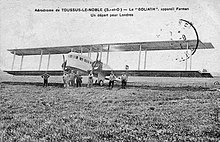Henri Farman
Henri Farman (born May 26, 1874 in Paris , † July 18, 1958 there ) was a French track cyclist , aviation pioneer, automobile racer and entrepreneur.
Life
education
Born to well-to-do English parents - his father was a correspondent for an English newspaper in Paris - Farman began training as an artist, but soon became interested in the latest technological advances and sport.
So he initially competed in bicycle races and became a French stay-up champion . In 1893 he went with Edouard de Perrodil on a bike tour from Paris to Madrid ; then Perrodil published the book Vélo! Toro! Paris-Madrid à bicyclette en 1893 , to which Farman contributed the drawings. With the automobile races emerging at the turn of the 20th century, he began a career as a racing driver, initially in a Panhard & Levassor . He later switched to a Renault . For Panhard he finished, for example in 1902 when over three days lasting race Paris-Vienna behind Marcel Renault in second place and in 1903 the Gordon Bennett Cup in Ireland Athy third. In 1907 and 1908 he entered the French Grand Prix , but could not achieve any results worth mentioning.
Aviation pioneer and entrepreneur


An accident Farman turned now of flying to and acquired in 1907 as one of the first customers Voisin - engine aircraft of the designer Gabriel Voisin . Since the brothers Voisin anbrachten the owner's name clearly visible on the rear part of the fuselage, this machine was as Voisin-Farman I known.
Farman and his brother Maurice immediately began modifying this machine. On October 26, 1907, he achieved the world speed record for land planes with 52.7 km / h in this aircraft at the Issy-les-Moulineaux airfield .
On January 13, 1908, Henri Farman also succeeded in the world's first powered flight over a distance of one kilometer in Issy-les-Moulineaux. For this achievement he received the Grand Prix d'Aviation endowed with 50,000 francs . In the following years he was able to increase the flying distance up to 24.125 km.
It was also Farman who carried the world's first passenger in an airplane on March 29, 1908: Léon Delagrange. In memory of this pioneering achievement, the Farman Nunatak in the Antarctic bears his name. In 1908, Farman ran a flight school in Buc near Versailles. On October 30, 1908, Farman flew 27 kilometers from Chalons to Reims in 20 minutes . This flight was reported by Scientific American as the first European overland flight (see picture).
After a dispute with Gabriel Voisin, he developed and built the Farman III in 1909 , first flight April 6, 1909. With this machine, equipped with ailerons , he won several prizes at the 1909 flight week in Reims .
In mid-November 1910 he (presumably the first) to set up a passenger transport line by airplanes between Buc , where his workshops were, and Etampes , where his airfield was. The distance of 40 km was marked by flags.
In 1912 he founded an aircraft manufacturing company in Boulogne-Billancourt with his brothers Maurice, who had previously designed aircraft in Buc, and Richard. There they first produced the characteristic biplanes with pressure propellers, which were mainly used for military purposes and training flights.
Farman aircraft participated on the Allied side in World War I as reconnaissance and observation machines. The best known representatives were the Farman MF7 and the Farman MF11 . The MF7 was intended as a reconnaissance aircraft, while the MF11 was a light fighter aircraft and was nicknamed the Shorthorn . Both models were two-seater biplanes.

The FF.60 bomber prototype from 1918, a further development of the bombers built by Farman in Boulogne-Billancourt, was redesigned into a passenger plane at the end of the war by changing the airframe. The aircraft called the Farman F.60 "Goliath" had its maiden flight in January 1919. From February 8, 1919, the newly founded Lignes Aériennes Farman set up the first international scheduled connection on the route from Toussus-le-Noble near Paris to the Royal Air Force Station Kenley near London . The twin-engine Farman F.60 broke several flight records and became a milestone in the French civil aviation of the time and in large parts of Europe. The first French scheduled airline Lignes Aériennes Farman later went over to Air France .
In 1919, Henri Farman received the title of Knight of the Legion of Honor for his services to French aviation .
In 1937, a year after the nationalization of the French aviation industry, including his company, Farman withdrew from the aircraft business. The company continues to operate under the name SNCAC ( Société Nationale de Constructions Aéronautiques du Center ). Until the takeover, the machines had the Farmans' names in front of the type designation.
See also
A ready-to-go HF-20 of the Swiss Air Force in World War I.
Farman MF11 Shorthorn , 1915
Web links
- Henri Farman in the Radsportseiten.net database
- Early Aviators Henri Farman
- The Farman Brothers
Individual evidence
- ^ Edouard de Perrodil (text) / Henri Farman (illustrations): Vélo! Toro! : Paris-Madrid à bicyclette en 1893 . 1893. New edition 2006. ISBN 978-2952422321
- ↑ Berliner Zeitung of March 29, 2008: Two men on board , queried on February 7, 2010
- ↑ February 8, 1919 - First international scheduled flight in the world. In: due date. WDR , February 8, 2019, accessed April 13, 2019 .
| personal data | |
|---|---|
| SURNAME | Farman, Henri |
| BRIEF DESCRIPTION | French track cyclist, aviation pioneer, racing car driver and entrepreneur |
| DATE OF BIRTH | May 26, 1874 |
| PLACE OF BIRTH | Paris |
| DATE OF DEATH | July 18, 1958 |
| Place of death | Paris |



